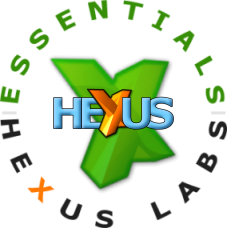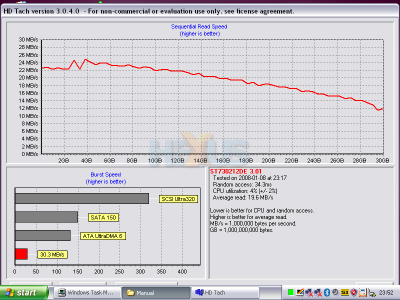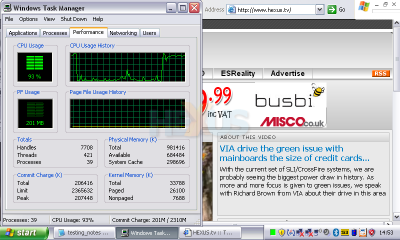Usage and final thoughts
The Packard Bell EasyNote XS20 ships with a full-fat copy of Microsoft Windows XP Home Edition. General usage feels a little sluggish, with the hard-drive being the main culprit.The figures tell all. The average read speed is <20MB/s; random access speed is 34.2ms; and burst speed is only 30.3MB/s. These figures represent less than half the performance associated with larger-capacity (2.5in) drives fitted into most laptops, meaning that portability comes at a rather large performance cost.
We ran a single benchmark from our usual suite - the multi-core-aware DivX encoding test. Arbitrarily comparing to a Dell XPS M1330 - the first that came to hand - running a dual-core Intel Core 2 Duo Mobile T7250 CPU at 2.0GHz, the EasyNote XS20 took 17m 40s to encode the 416MB clip, compared to 3m 2s for the Dell.
But whilst running CPU-intensive applications gives us a look into pure performance, it misses the point somewhat - that's not what the XS20 is all about.
The sub-notebook chugged through the usual spreadsheet and web-surfing activities that it would be expected to encounter on a day-to-day basis.
Putting it to a more-stringent test by initiating playback of a Flash-encoded clip from HEXUS.tv, performance left something to be desired on a file-format used by pervasive YouTube.
The playback load hit 100 per cent on a consistent basis and resulted in a stuttering experience, even though the VIA C7-M processor did effectively clock up to 1.2GHz when placed under load. Compare this with a 15-20 per cent load for the Dell XPS M1330.
Final thoughts
Based on VIA's reference NanoBook design and weighing in at only 933g, including four-cell battery, the £349.99 Packard Bell EasyNote XS20 seems to have the mobility boxes ticket when evaluated at first glance. This supposition appears to be corroborated when looking at the battery-life statistics and excellent, if somewhat low-resolution, screen.Digging deeper and cracks in its armour become apparent. The slow-spinning hard-drive reduces Windows XP to, at times, a crawl, and the VIA C7-M processor makes heavy weather of running Flash-encoded clips without stuttering. While we're at it, the keyboard could do with an ergonomic make-over, too.
We'd be able to overlook many of these foibles if, like the £220 (Linux-based) ASUS Eee 4GiB PC, the price was more competitive. However, even at £349.99, and appreciating that it ships with a complete operating system, the XS20 competes against a range of more-powerful 2kg laptops whose feature-set is far more compelling.
We reckon that Packard Bell will still sell a significant number of EasyNote XS20s, borne from the simple fact that it's so damn portable, but we reckon a processor upgrade is in order for it to take advantage of the immersive nature of the Web in 2008.
Bottom line: superbly portable and well-built, the Packard Bell EasyNote XS20 isn't quite the panacea to the mobile warrior's computing woes. It's a little too expensive, underpowered, and, frankly, slow for it to receive an outright recommendation to buy.
HEXUS.certification

Packard Bell EasyNote XS20















